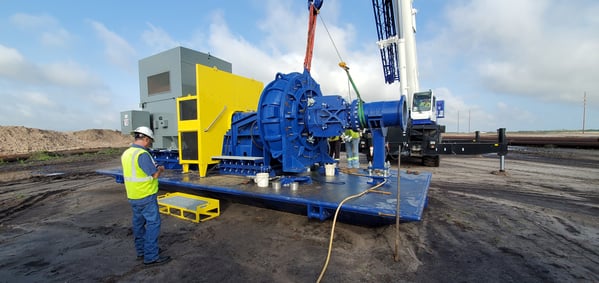
Phosphate is vital to industries as varied as technology, green energy, and fertilizer production, but phosphate mining and distribution is complicated by global economic and political activity. To understand the intricacies of the global market, it’s useful to know where phosphate is found and how current events affect the sale and shipment of this critical mineral.
Global supply
China is the global leader in current phosphate production at 85 million tons. Morocco comes in a distant second at 38 million tons, and the United States ranks third at 22 million tons. The four other significant producers are Russia (12.5 million tons), Jordan (9.2 million tons), Saudi Arabia (8.5 million tons), and Brazil (5.5 million tons).
The distribution of global phosphate reserves looks quite different. Morocco’s reserve is the largest by far at 50 billion tons. Second place goes to China with 3.2 billion tons, closely followed by Egypt at 2.8 billion tons, and Algeria at 2.2 billion tons. Brazil and South Africa are tied for fifth place at 1.6 billion tons. The remaining significant reserves belong to Saudi Arabia (1.4 billion tons), Australia (1.1 billion tons), Finland (1.0 billion tons), and the United States (1.0 billion tons).
According to the 2022 U.S. Geological Survey Mineral Commodity Summary prepared by Stephen M. Jasinski, capacity expansion projects are ongoing in Brazil, Kazakhstan, Mexico, Russia, and South Africa.
- Brazil. EuroChem acquired the Yara Serra do Salitre phosphate complex in 2021. They plan to expand phosphate rock production from 600,000 metric tons per year to 1.2 million tons per year.
- Kazakhstan. Both EuroChem and Kazphosphate have plans to increase production capacity.
- Mexico. Odyssey Marine Exploration has proposed to mine phosphate-rich sediment from the seafloor in Baja, California.
- Russia. JSC Acron plans to expand production capacity at its mine in the Murmansk region.
- South Africa. Kropz PLC is developing the Elandsfontein mine. Planned capacity is 1 million metric tons per year. Kropz also is developing a mine in the Republic of Congo.
Political and economic effects
Erkki Kohtanen, VP of Sales and Marketing for Global Industrial Minerals and Dredging at GIW, reports phosphate prices are up since the start of the Russia-Ukraine War. “When Russian mines are not allowed to export, there is a decrease in global supply and a price increase on phosphate. We’re seeing more activity on phosphate mine projects in North Africa and South America. There is also activity in North America. Major Phosphate producers in Florida, Mosaic and Nutrien, are looking at options to extend operations or reprocess tailings to fulfill the global demand for phosphates and to secure domestic supplies.”
With the world population rising and climate change concerns affecting the quality and availability of fertile farmland, there’s a global increase in the demand for fertilizer. There is also more demand for lithium iron phosphate (LFP) batteries from the green energy sector. Between sociopolitical and demand concerns, phosphate production is expected to increase in Morocco, Jordan, Saudi Arabia, Brazil, and the U.S.

Meeting the demand
Centrifugal pumps are integral to phosphate fertilizer production. Phosphate rock is extracted, washed, and processed to produce finished products such as diammonium phosphate (DAP) and monoammonium phosphate (MAP). Pumps are required to move slurry, water, and chemicals throughout these processes. The first GIW® slurry pumps were sold to the Florida phosphate market in 1914. After more than 100 years of slurry pump troubleshooting and R&D for the phosphate market, KSB GIW, Inc.’s expertise has become a unique resource for the industry.
KSB GIW, Inc. also provides non-slurry pumps and pump-related services in support of phosphate mining in Morocco, Saudi Arabia, and Brazil. The company’s global goals include increasing its market share in these countries with GIW® slurry pumps as well as establishing a presence in the expanding phosphate markets of Jordan, Egypt, and Algeria.
Moving into these markets isn’t simply a matter of selling pumps. There is a significant investment in the development of local slurry pump experts. Local KSB mining industry teams must attend the KSB Mining Academy. The Academy includes application and pump selection training, hands-on maintenance activities, and mentoring by experienced experts. Once trained, KSB teams work with customers to provide a broad range of service and support, from pump troubleshooting to optimizing system efficiencies. KSB also provides assistance with spare parts inventory management. Teams collaborate with each customer to set up and manage appropriate inventory levels of wear parts for maintenance cycles, emergency stock, and even consignment stock.
Many KSB locations also offer local off-site maintenance and repair services to support client needs, including:
- Pump and cartridge bearing assembly (CBA) rebuild and remanufacture programs
- CBA exchange programs
- Engineered coatings for erosion and corrosion control
- Vibration analysis
The goal is to support each client with fast and flexible solutions to suit their constantly changing operational environments.
“KSB Mining wants to stay the number-one pump partner in the USA,” Kohtanen explained, “and at the same time, increase the market share in Morocco, Saudi Arabia, and Brazil. This requires not only a continued investment in R&D for pumping technology, but also an investment in the development of local expert teams.”
Current events have shaken up the phosphate market, and KSB stands ready to help global markets adjust. Whether it’s contending with sociopolitical disruption and sharp increases in demand or simply helping clients meet production goals, KSB has the technology, experience, and service support to help the mining industry adapt to changing circumstances.
